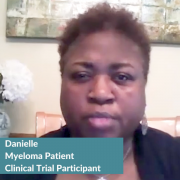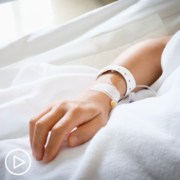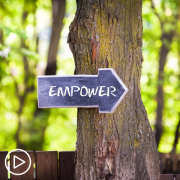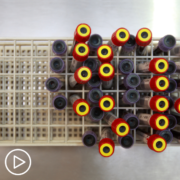Your Path to Empowerment | Myeloma: Treatment from Patient Empowerment Network on Vimeo.
Navigating treatment for multiple myeloma can easily become overwhelming. What education can you receive prior to treatment or what impact will a specific treatment have on your daily life? Hear from a panel of myeloma patient advocates who share their personal experiences, advice and various resources.
See More from Your Path to Empowerment | Myeloma
Related Programs:
Transcript:
Lisa Hatfield:
Okay, hello and welcome to our Path to Empowerment Living with Multiple Myeloma program here at Patient Empowerment Network. I am the myeloma Empowerment Lead here at Patient Empowerment Network. My name is Lisa, and I’m also a myeloma patient diagnosed back in April of 2018, I started having a pretty significant pain in my hip about one or two years before I was diagnosed, how to spine x-ray didn’t show anything in about five months later, went in for an MRI and was diagnosed with a large plasmacytoma that had eaten away a part of my spine, I have been fortunate enough to have care at MD Anderson. I was able to go down there, both for my spine and for my cancer. I met with the radiation oncologist immediately upon going to MD Anderson, who had me go through eight sessions of radiation. My treatment consisted of the radiation and then spine surgery to support my spine because my spine was compromised and close to the tumors close to my spinal cord, all of that was followed by… I met with myeloma specialist, Dr. Karina Patel at MD Anderson, and she wrote my prescription and orders for chemo to be done back in my hometown in Boise, Idaho.
So, I came home for six months of chemo, and I had it every week for three weeks on one week off, and my chemo treatment consisted of KRD, which is carfilzomib, Revlimid and Dex also known as Kyrpolis, Lenalidomide and Dexamethasone. I did have that for six months on, like I said, three weeks on one week off. Had a great response. My last treatment that I had, I followed that up by going to Seattle to have stem cells collected and was also re-staged, my cancer was re-staged in Seattle was MRD negative, ten to minus five, but at that point, I opted to wait to have my stem cell transplant until first relapse, and since then I’ve been on maintenance therapy for about three and a half years, Revlimid also called Lenalidomide was on it every day until about a year ago when I was given one week off after three weeks on and for the past 10 weeks, I’ve been completely off of maintenance therapy due to side effects of getting progressively worse, including neuropathy and digestive side effects, so that is my history with myeloma, we are very fortunate today to have two other patient panelists, Jim and Sheri, who will introduce themselves.
I’m going to back up for just a minute, people like to know the type of myeloma we have, I have kappa light chain only myeloma, which means I do not have an M spike, I’m followed with the free light chain that shows kappa light chains in my blood and also a 24-hour urine, that shows Bence-Jones proteins in the urine. So, kappa light chain only, my cytogenetics, I feel like I have to share my zodiac side too, but my cytogenetics are translocation, 11, 14 and monosomer 13. So we’ll move on to our patient panelists, welcome them. Sheri, she’s a support group leader for the International Myeloma Foundation here in the Treasure Valley and Boise, Idaho. So Sheri, if you could just introduce yourself, please, and explain your history with myeloma, the treatments you’ve had, current status and type of myeloma. That would be great.
Sheri Baker:
I’m Sheri, and I was diagnosed in October 2011 with IgG Kappa myeloma. We found my myeloma because through blood work to check, just kind of more of a routine check, it was discovered that I had kidney failure, and my kidneys were only functioning at 8%… Normally should be 100% or close to that, so 8% kidney function. Didn’t know why. It took a couple of weeks and a bone marrow biopsy to figure out that it was because of myeloma. So, IgG Kappa, but no cytogenetic markers now, high risk markers, just standard, normal myeloma, but it did attack my kidneys versus my bones, very minor minor small lesions that I had. Anyways, that was 2011, in October, within a couple of weeks, I started dialysis and started my first treatment, which was in 2011, they weren’t really doing doublets and triplets very much, so it was, well, a doublet, if you want to consider Velcade, which is bortezomib plus Dexamethasone. So, I was on those two, and I did four cycles from October to the end of December to get me ready and see if I had a good response for a stem cell transplant.
I had a stem cell transplant in March of 2012, I got a very good partial response for my stem cell transplant, still had a small M-spike, but because of the dialysis and my kidney issues, I decided not to do maintenance therapy, I’m really the only or the standard maintenance therapy was Revlimid, and I know Revlimid can be tough on your kidneys, so I decided after researching it and talking with my doctor not to do maintenance therapy, so I was off of therapy for two years, but my numbers had started to increase. So in April of 2014, when faced with having to go back on something, I asked my doctor if I could do Velcade again because I’d only done it for four cycles, really only about two months’ worth, and he looked into it and said, yeah, so that’s what I did for six years, Velcade as therapy, maintenance therapy, if you want to call it that, but I did it solid three weeks on, one week off for six years, when that started to quit working and I started looking at changing treatment again. I changed to Darzalex Faspro, Revlimid this time at a low dose and Dexamethasone.
And it has been two years since I started that treatment. I’m now on monthly Darzalex, and I stopped the Revlimid in February because again, lower blood counts and it could be tough on your body, and I stopped the dexamethasone as well, so I’m only on Darzalex once a month, and it seems to be holding. It did finally put me into a zero M spike, complete remission, which I really hadn’t been in 10 years, so that’s a good thing, and I’m still holding my own with that right now, so that’s my story. And I was able to get off of dialysis. I was only on dialysis for two years, and my kidneys recovered just barely enough to stop dialysis and they have slowly improved over the 10 years or over the eight years, and my kidney functions generally around 25% right now. So that’s where I’m at.
Lisa Hatfield:
Thank you. Well, thanks Sheri. Jim, if you would please introduce yourself and give a little bit about your history and the treatment that you’ve had.
Jim Bond:
I am James Bond, and I’m the real James Bond, I’m not the movie actor. And my beautiful caregiving wife, Kathleen, if she were here with me, you would believe that I am the real James Bond. But I was diagnosed in 1992, so that was 30 years ago, and I was at stage three with Kappa light chain, like you, Lisa, and I’ve had some treatments during those 30 years, and I can recap those for you. It’s pretty easy. The first 10 years I had three transplants, there were no current day modern drugs for myeloma available, and I was one of the pioneers in the clinic trial that got Velcade approved. In fact, it saved my life when I was told to go to a hospice and I was lucky enough to get in the trial, and that was up in Boston, away from our home, and home run got saved and Velcade got approved, and I’ve really not been in danger with myeloma since then, although I have been in a total of six clinical trials, including Revlimid that you’ve been on Lisa and help that one get approved, but ever since, Velcade my myeloma has not been life threatening.
Another highlight of the treatments that you asked her to sell is that I did get treatment-related leukemia, and they’re not… Positive why. One of my transplants, I had to have full body radiation as part of the protocol, and I took some other drugs like Melphalan and we all have to take for transplant, but those were leading suspects of what may have caused the treatment-related leukemia. But I was very, very fortunate and they were able to find an unrelated donor, and I haven’t matched my stem cells, and I had a fourth stem cell transplant over a decade ago, and that put the leukemia in remission and where I remained today on both cancers side note to the last allo transplant, my four transplants break down two autos and two allos, but my last allo was from a woman living in Germany and it kind of explained to me why ever since that transplant, I’ve had this urge to go to October Fest.
More seriously, I’ve had some serious side effects, the most prominent of which is graph vs host disease from the other person cells, which affects my skin, my gut, and surprisingly the surface of my eyes. I had to get special contact lenses that I have to delicately put in, take out every day to return my sight to normal, but it’s worked out really well.
Lisa Hatfield:
Thank you, Jim. And I’ll just provide a quick reminder that this program is based solely off of our patient experiences and should not be substituted for medical advice, so please see your physician or any qualified healthcare provider if you have any questions about your medical conditions including myeloma. You do have an opportunity to ask questions of the patient panelists at the end of this program. If you use on your zoom, there should be two little buttons one a Q and A function and one a chat box, submit your questions there and are behind the scenes, producer will be watching for those questions, and our patient panelists are available to answer those questions at the end of our program, just that reminder, but with our medical disclaimer.
So, we’re going to jump right into our questions that we have now for the patient panelists, and Jim, I think I’ll start with you, you already established some of the treatments that you had, but sometimes when I go to our support group meetings for which Sheri leads this group here locally, people will say things like, I really wish I had known this about treatments. Is there any one or two things that you wish you had know looking back now, that you wish you had known going into any particular treatment that you do know now?
James Bond:
Yes, there are a couple that stand out and they’re the subject not only of my book and our talks, but I started doing episodes, four-minute episodes on YouTube, and one of those episodes is on my experience with using steroids, which one or both of you mentioned Dex is one of the components to one of your treatments. So, dexamethasone is the most powerful steroid that I use, and it was required with getting me ready for my first second, third and fourth transplants, and it was also a steroid that was used for a while I did do maintenance before I got leukemia. And the thing I wish I had known about steroids from beginning is after I had a hip or one of my two hips replaced, the hip surgeon told me, Jim, you cancer patients are higher risk for needing to get a hip replaced. Something called avascular necrosis because of the long-term use of steroids that you’re required to do. Well, when I found that out. It’s been 15 years ago. I started challenging my doctor, I said, look, can we try that maintenance that you’ve got me doing, but do it without the prednisone steroid, and he balked at that because that wasn’t the way that they were doing it.
But I said, how can we work it out? Because I’d really rather not get the other hip replaced, lower my risk, and we agree to something in between, and he said If you’re willing to come in here every six weeks and monitor your blood, that I’d be happy with you staying on no maintenance. So that’s really what I’ve been doing. And I know that earlier on, I probably would stop the prednisone earlier on, there’s nothing I can do about the dex required for getting me ready for the transplant. That was part of my story. But that would have been helpful to know.
Lisa Hatfield:
So, one of the questions too that somebody asked me a while back, had been diagnosed for a few years, gone through induction, stem cell transplant, lived in the Boise area, had never seen a specialist. Can a person, if they haven’t seen a specialist from diagnosis or can they seek advice of a specialist anywhere during their myeloma journey?
Sheri Baker:
Yeah, I think so, for sure. For the first, probably two and a half years, maybe. I didn’t consider seeing a specialist because what I was doing was pretty straightforward, I had standard risk myeloma, and I was a newbie, I was a rookie, and I just kind of went along with what my doctor said to do, and I don’t think I did anything wrong; I don’t think I made a wrong turn; I should have done something different. But the more I started reading and researching, the more I realized that being with someone who deals with just myeloma and a large number of myeloma patients, because like Jim said, everybody’s myeloma is different, so when you see someone who’s dealt with a variety of myeloma cases and can see the differences, it’s helpful, so that’s when I saw… It was probably closer to three years in my journey before I saw a specialist, and then I didn’t have… And I saw that specialist, I saw her for a couple of years, once a year, kind of a thing, and my myeloma was stable. Once my myeloma changed and I wanted to see somebody closer to home, relatively speaking, I changed specialist because it was easier to see and travel to, and again, I knew my myeloma was on the rise again, and I wanted to get a specialist opinion, because there are so many choices of treatment and this was just two years ago.
And the landscape of myeloma had changed drastically, so I really wanted to see a specialist and find out… Now, what do I do now that I’m making a change? And so, I think anywhere in your journey, if you’ve never seen a specialist, you can certainly see one, and I know as a support group leader, I’m very happy that I have convinced some members of my support group to see a specialist because their myeloma is getting tricky to handle… And they need someone who has seen more cases and has a better idea of where, what they should do at that point.
Lisa Hatfield:
How did you choose your myeloma specialist?
Sheri Baker:
It was funny, my husband said, we’re going to go see a specialist, we’re going to see one of the best, so we kind of looked at the top 10 list, we went off of a website that had done a lot of research and ranked enlisted specialists and this specialist at Duke, my son was living in North Carolina and we thought, Well, she’s one of the best. We can visit him and we can go to the specialist, so that’s why we chose to go all the way across country and see a specialist.
Sheri Baker:
When I changed specialist, one of the reasons was my son had moved back to Idaho, I didn’t need to go to North Carolina anymore, and I had met this specialist in person, really liked him, had a good rapport, my husband met him at a patient conference and really liked him as well, and he said, we should see if we can switch. And see him now because it’s closer, and I just really like him, so that’s how I made my decision there.
James Bond:
One of the questions on the homework was, so what about access to treatments? And I’d like to say something about that. We had to pull up stakes at the drop of a hat and relocate 600 miles from Cleveland, Ohio to Boston, Mass for this all important turned out to be a Velcade trial and we were able to do that financially. I had a great job, I was still working, great insurance. And my wife and I looked at each other and thought, what about people who don’t have the resources to do this? And my wife is a 40-year volunteer for the American Cancer Society, and she’s become a real leader with them, including the national board of directors. Well, she pointed out that that’s why the American Cancer Society has over 30 hope lodges around the country, where cancer patients and a caregiver stay for free while they’re being treated typically for an out-of-town treatment they can’t get at home.
And that’s really good information for people to know because even though there’s only 30, there are a lot of cities and states in our country, the American Cancer Society has a relationship with at least one hotel chain where they can help with very inexpensive accommodations while you’re out of town for cancer. So, the American Cancer Society, 24 hours, seven days a week, support line. It’s really some place to look, if you’re having trouble with finances on getting out of town.
Lisa Hatfield:
Thanks, Jim. And you mentioned something too, I think we’re all on board with our feelings that seeing a specialist is critical on your myeloma journey at some point, however, that requires the financial means to be able to do that, to be able to travel, to pay any co-pays or out-of-pocket expenses that you might accumulate from that, or even when we went down to MD Anderson, I was scheduled to go to appointments for five days, we stayed down there for a month because I had to have an emergency spine surgery. All of those are unexpected expenses, so I just want to say if anyone has questions, as they’re watching this feel free to contact me. I have an email, cure4mm@gmail.com. It’s the number four. I won’t know all the answers, I have a lot of great resources, including Sheri, who leads our support group to help try to find resources for people who are seeking a second opinion or a myeloma specialist. Even if it’s just once during your myeloma journey, please reach out because there are resources out there, whether it’s through the IMF or the LLS, the Leukemia Lymphoma Society, there are resources, it’s critical to seek out the advice of a specialist at least once during your myeloma journey.
So just wanted to put that out there. And Jim, I do have another question for you. I did read your book, I have it right here. Thank you for doing that is a very easy to read book and it provided a great perspective on because myeloma is incurable, how can we live with this for 30 years, and still live our lives while going through treatment after treatment, and you had great insight and inspiration in your book about that. So, thank you for putting that out there, but it brings up a big question that I had, and I still have… You had talked about the plasmacytoma that had developed on your head and had radiation, and I think it was that point, I have ear marked in the book, one of my big… I’m terrified when I ask a question of a doctor, because I’m afraid it’s going to appear that I’m questioning their expertise, if I disagree with the treatment or if I’m uneasy with the treatment. I have a hard time saying, hey, I think that this might be a better option for me. Well, in your story, you had during this time of this plasmacytoma, you mentioned that you were on a maintenance drug, your doctor, one of your doctors wanted to add a second drug, I believe, to your maintenance regimen, just to make sure that everything was knocked down as much as it could be your abnormal proteins for increasing, you felt you just want to increase the dose of the one drug you were on rather than adding another drug.
My question for you is, you did approach your position, you had a method of doing it… How did you do that?
James Bond:
Yes, that was the most contentious I’ve ever been with my myeloma expert, Paul Richardson. He and I and my wife are really good friends, I mean that. We’re talking close friends. So, I was at that point where I was on a little bit of a maintenance drug, I think it was Revlimid and my protein started to go up, and Paul wanted me to add Velcade to it. Well, my strategy is I wanted to hold on to Velcade in case my life was ever in danger because it was one that really saved me when it was, and so I resisted and I said, Paul, let’s just try increasing the dose. And he resisted, and there was a little contentious over the telephone, finally… And here’s the key, we have had a really good relationship with Paul’s oncology nurse, Debbie. Debbie is now retired. Debbie said, Jim, let me talk to you privately. She and I got on the phone primarily without Paul, and she said, Jim, here’s the thing, you’re not going to convince Paul based on the myeloma knowledge, he wins that argument every time because he knows it. She said, what you can make progress on is what you’re comfortable with, and if you come out of it at a standpoint say Paul, I’d be more comfortable trying to increase my dose and give it a month and see how that goes.
That worked like a charm. And so, it was a study nurse who got involved, saw that she had two people who were kind of dug in and listened to her closely, and that really mitigated what could have been a difficult situation. Here’s the really surprising thing and great thing is then after I had the dose, and he had me do another this and another that to make sure there was no other problems in my body, and when the protein went down at the higher dose, I thought he might be a little bit remissed, dumb luck or not my call worked out. First thing out of his mouth on the phone was Jim, good call. Good for you. So that’s the kind of guy he is. He puts ego aside and he just wants to do the right thing for his patients. Same Doctor called me at 8 O’clock at night. I was having real difficulty with that fourth transplant, the one for leukemia, I was there for 75 straight days, and he called me one Sunday night and assured me I’d make it through. That meant a lot to me at the time and it still does and that did help me get through with the thing.
So, our relationship with doctors is really important, and you’re right, not to want to rile your relationship with your doctor, but the words I’m more comfortable with go a long way with me and my doctor.
Lisa Hatfield:
That’s a great piece of advice going in, especially for those of us who don’t want to question the medical expertise to say something like that, I’m more comfortable with this, and then they can consider it, and I think it’s a team effort, it’s a collaboration when you’re dealing with the lifelong disease like myeloma it has to be a collaborative effort. For the best outcome, so that.
James Bond:
We look at it like you know the science and the biology, and that’s great, but we know 30 years of history and we know our own risk tolerance, and by putting those two together and collaborating, like you said, was… I think we get the best to answer.
Lisa Hatfield:
Yeah. Great, thank you. So, Sheri, I know that you have gone through… Well, you had dialysis, there are all kinds of treatments that are involved with myeloma, we have radiation, we have surgery, we have chemo, some people have dialysis, stem cell transplant, so focusing on the chemo aspect, because I believe every myeloma patient will have chemo at some point. Some of the questions that come up with that, or what is that like when you go and did you… When you were first diagnosed, were you able to do some of your own prepping to develop questions, and did somebody prep you? Did they provide any education? What should it even look like when you went into the chemo… What did it feel like when you walked in there? I just figured when I went in, it would be people laying in bed getting sick, they’re all going through chemo, and nobody would have any hair, 80% of the people had hair still, so what was it like for you when you first started chemo? What kind of education did you get and what did it feel like just walking into that chemo suite the first time?
Sheri Baker:
Well, it’s funny because it was almost 11 years ago, and it’s very different than it is now, there was kind of no real walking you around the chemo Suite and what not in my case, I think it’s because I saw my doctor downtown in Boise, but because I live in Meridian, just outside of Boise, I went to the facility that was there because it’s a little closer to home for most of my treatments, but I liked my doctor who was downtown, so I wanted to go there so anyway, I think because I was back and forth between the two, maybe.
But now I know that they have a program with new patients where they walk them around, they show them the chemo suite, they show where you’re going to get your treatments, and so it’s very different from when I first went in 11 years ago. In fact, when I went in, I really didn’t know what… I knew what the name of the treatment was, but I did not know anything else. I didn’t know how it would be administered, nothing. And they had just started in our hospital here locally, they had just… And I think most of the country had just started switching over from Velcade, which was given in the IV form in the beginning for years to the sub-q injection. So, when I sat down to get my first chemo, because I didn’t know any better, the nurse started an IV in my hand, but then somewhere along the lines in my head, I was like, I thought this was going to be a shot, but I just didn’t know what they were doing… And so, I asked her, I said, aren’t I supposed to get this as a shot in my arm at the time, I thought…
And she’s like, oh my gosh, I am so sorry. And ended up taking the IV out, and to this day, I still tease her about that. But yeah, I feel like I was a little unprepared, I don’t think the hospital necessarily did a good job of preparing in the beginning, I think they have gotten much better about that, but I do always try to… I try to help the hospital from a patient perspective of, you really need to do this when I was a brand-new patient, this is what I would like to have had. I would like someone to have told me about a support group, I would like them to have told me what my treatment was actually going to be like on that first day, and I think they’re getting better about that, but a lot of that is on us as being your own best advocate, you know, like Jim said, you know they know the myeloma stuff, but you know your body, you know yourself, you know what you’re comfortable with, so you have to ask, at some point in my six… Six years of getting Velcade after I relapsed the first, probably two years, I got the shot in the back of my arm because that’s what everybody did, but then I read about it online and…
Yeah, you can’t trust everything you read online, you have to be careful. But I read that it was… A lot of people were getting it in their belly, that it was originally intended to go in your belly, and I asked about it and they’re like, Well, yeah, we can do that, and now most people I know at the clinic do get it in their belly, so it’s just a matter of educating yourself and asking questions, and don’t hesitate to ask a question, that’s the only way that you will get answers, it’s the only way you learn, and sometimes it helps educate the doctors and nurses around you as well.
Lisa Hatfield:
Thanks. So do you think of a patient… A new patient is going into chemo, it’s really uncomfortable. Do you think they would be able to ask, hey, can I have a tour of the chemo suite the week before or a day before my treatment begins. Do you think that would be a reasonable question?
Sheri Baker:
I think it’s definitely a reasonable question, and obviously cancer centers across the country, I have no idea how they do it, but I know ours here locally is getting better about doing that, it’s a process now, before your first treatment, they’ll walk you around and show you everything so you have an idea of what to expect and you’re comfortable or as comfortable as you can be on your first treatment day.
Lisa Hatfield:
I have one more or two more questions I’m going to have… I wanted to ask really quickly, both of you can respond to this Jim, we’ll start with you, during all of your treatments, have you had any unusual side effects that nobody was able to explain or that you hadn’t heard of prior to starting that treatment?
James Bond:
Yeah, probably the emotions got away from me at one point, I lost my temper when I shouldn’t have, and I attribute that to everything about that. I don’t know if it’s just steroids or just the treatments or what… But I like to ask questions, I’m not afraid to ask questions. And I read the signals to my family that I needed to do something differently, and I asked my oncologist who had to become really good friends with here in Cleveland and he recommended a professional and I sought his help, and he sat me down and he gave me some really good advice that I still live by. So, you know, that’s something I didn’t expect and I don’t know if I could have prepared for it, but just being flexible in letting your ego leave at the door step and just realize, hey, you need these people’s help to get yourself going, and just accept, in my case, accept that I’m not as young as I used to be for one, 73 is not 43. And there’s certain things I just can’t do anymore. So, you just got to kind of roll with that, so I hope that’s of some value.
Lisa Hatfield:
So, Sheri, I know you had an unusual side effect because we talked about it, it was to Revlimid, and I remember getting the same side effect early on in my treatment, I was a really, really itchy scalp in the middle of the night, scratching… And the pharmacist actually talked to, didn’t even know about it, so you and I talked about that, that was one of my unusual side effects that a lot of people didn’t know about. Have you had any other unusual side effects that even your providers were a little bit curious why that was going on, and you think it was from the treatment?
Sheri Baker:
When I was on Velcade, I kept getting styes on my eye like right in my eye lash line, upper or lower. And we think that now that that… I’ve seen a lot of other people comment on Velcade, they have that as well, but at the time, doctors didn’t really seem to know that that was a side effect of the Velcade. I think that’s why it’s so important when you have a little… I shouldn’t say little, any kind of side effect or something that you have and you should ask and you need to report it to your doctor and kind of report it to the pharmaceutical company because if these things are happening with other patients, but nobody tells the pharmaceutical company then they don’t know that’s a side effect of that particular drug, so that’s probably one of the ones that we weren’t sure that and a lot of cramping, hands, feet, my face, that’s what led me to get blood work in the very beginning when I first got diagnosed was an excessive amount of cramping in my legs and feet, but after I started Revlimid, I had a lot of cramping, cramping, like my face would cramp, cramping in my hands, and we lowered my dosage of Revlimid and that did help, but I don’t know how many people get that to the point where I couldn’t even drive the car, my hands cramped up so bad that I had to pull over until the camping stopped because both hands were cramping, so those are probably the more…
I don’t know if they’re unusual, I think a lot of people may get them, but not an easy thing to solve, an itchy scalp…That is crazy. That is crazy. I just saw someone who just quit Revlimid and then got the itchy scalp and she asked, has anybody gotten that when they quit the Revlimid because she goes, now that I’ve been off of it, I have a really itchy scalp, like you say, the cancer itself is different in everybody… And then everybody’s side effects are just slightly different, so…
Lisa Hatfield:
I think you’re right, that’s why I like talking to other patients because these unusual things the doctor does not know what it is, but you talked to somebody else, like I had that same exact thing happen. You’re right, I reiterate what you say let your provider know when you have side effects and maybe even let the pharmacy or a pharmacist at the cancer center now so they can report that accordingly.
So that’s my last question is one takeaway that both of you have, whether it has to do with the emotional or mental health challenges of having myeloma or just dealing with even more acute things like, oh my gosh, I’ve got a new treatment, how to deal with that emotionally, one take away that each of you has to help my myeloma patients as they go through the treatments with myeloma. Sheri, do you have one thing that you can leave everyone with or talk about the emotional challenges that you have, how you’ve dealt with them?
Sheri Baker:
You know, I think that I am different than most people in the beginning, it was a devastating diagnosis. When they tell you three to five years, that’s devastating, because then you start… I was only 49 so you start thinking about all the things that you thought you were going to have in your life, watching your kids get married, having grandchildren, retiring together, living out your… traveling, doing all these things you think you’re going to do, and when you get that first diagnosis it just throws everything in the trash can and so the first six months to a year probably, I focused a lot on that, but then you start to adapt and you’re living with it, and it’s not as bad as what you thought it was going to be in the beginning, and it’s a cancer that we will live with the rest of our lives most likely, hopefully 30 years like Jim. I’ve made it almost 11 years, which didn’t think would happen in the beginning, so now… It’s just part of my life, it’s like, I hate the term, that it’s a chronic illness. I don’t like that it is still cancer, it is not just a chronic illness, but yet that is how we live with it every day, like if you have diabetes, you get up and you take your insulin or whatever, you take every day for diabetes, same thing I get up every day, take a whole host of pills, go once a month for a treatment that keeps me going, it’s just a part of my life now, but being a patient advocate has made it a little different where it is always in the forefront of my mind.
Everywhere I go, everything I do, I think about it from the support group standpoint or for me as a patient standpoint or whatever, but I think I like Jim, I do that maybe I need to not think about it so that I don’t get burned out. But I’m one of those people that has always had a positive attitude about it, and I feel like for me, it’s been easier to deal with than what a lot of other people go through, which is one of the reasons that I’m glad I started the support group to hopefully help people deal with it a little bit better, but yeah, it definitely changes what you thought he… And Jim was young when he was diagnosed, it changes what you think your life… The rest of your life is going to be like… You know, at least that little map you had in your head of how things would go, but I am just… I don’t know, I just deal with it, I think easier than a lot of other people, it’s never been out of my head to say to have a positive attitude, and I know people get sick of that, you got to have it.
It’s all about the attitude, but that’s just been easy for me and that’s how I’ve always been… My whole life has been on the upbeat side. So, it’s been lucky for me.
James Bond:
Thank you for being a support group leader, you help many others, they’re closing thought All The you with us. When we have this incurable deadly disease, keep making your long-term plans don’t feel like cancer will get in your way; you have to change a plan so be it. Keep making your plans. Live your life. You can do it. Hang in there.
Lisa Hatfield:
Thank you so much to both of you for those positive words of wisdom, keep making your plans. The first thing I did when I found it was telling my husband, we have to update our will, so we move forward with our plans for travel and that type of thing. Great advice, and I really appreciate that. So, thank you to both of you so much for your information and for sharing your experience. We’re going to move on now to the Q and A section, so I’ll remind everybody who is watching this to use the little buttons at the bottom of your screen, the Q and A function, the chat function, and our producer will be forwarding those off to our patient panelists. Thank you.
Well, welcome everybody to our live Q and A session, as you can see, it’s a different day, that was a pre-recorded session, so I’m going to welcome back Jim and Sheri, and they will be on to answer questions. We have a number of questions on the Q and A, we have a number of questions that were submitted via email and during registration, we’ll get through as many of those as we can, I just want to send a reminder to everybody that we are not…
Your healthcare providers, we’re just strictly speaking from our own experiences, patients, we encourage you to talk to our healthcare team, and even if you get one little piece of information from this program and you’d like to take that back to your doctor… I’m sure they would be willing to talk with you about that. So please remember that as you’re asking questions to questions a little bit more general, and to understand that we can’t answer medical questions directly, but we will speak with our own experiences to your questions. I’m going to jump right in, and one of the questions that was submitted during registration will start with that, this point will be for sharing, and again, she can’t necessarily speak to the efficacy of treatment, but she can speak to come experience. So, the question is what other effective treatments are there for those in multiple myeloma remission, besides Revlimid. If you could just review again, you were on Revlimid for maintenance therapy. I assume this person is referring to maintenance therapy. What other medications have you been on? And again, she’s not endorsing these medications. She’s just strictly maybe giving you some ideas to talk to your doctor about. So, Sheri?
Sheri Baker:
Yeah, in the beginning, when I decided to start treatment again, because I didn’t do maintenance right after my stem cell transplant, but when I decided to start treatment or needed to start treatment again, I was on Velcade. My husband always called it being on treatment, not maintenance, because it was three weeks on one week off, and I did that for six years, so that along with dexamethasone for probably two of those six years. That is a treatment option, and it’s typically an upfront treatment option for people, and it can be… I know quite a lot of people who are on Velcade as a maintenance program, there’s obviously Revlimid. And I’m on Darzalex now, which again was given when my cancer markers and numbers, my M spike was increasing and I needed to change treatment, so I was given Darzalex, Revlimid, and Dex, and I’m still on Darzalex now as by itself, if the Revlimid had not lowered my blood count, so drastically and they weren’t bouncing back on my weeks off, I would have still been on Darzalex and Revlimid as maintenance, but now I’m just on Darzalex maintenance. So, those are some options that I’ve had experience with.
Lisa Hatfield:
And that’s great to hear because I know that kind of the go to for maintenance is Revlimid. That’s what I’ve always been on, so I don’t have experience with anything else, and as long as you were talking, Sheri there was a question that you were going to answer live about what you would do differently if you were diagnosed, could you answer that question for the audience, please?
Sheri Baker:
Yeah, you know, years ago, before I was on Revlimid, in my head, I said If I had it to do differently, again, I do two things, one, I would have consulted with a specialist right from the very beginning, and through that, I probably would have gone ahead and gone on Revlimid maintenance after my stem cell transplant, even though I was on dialysis, because a couple of years later, speaking to a specialist, she said Revlimid can be dosed accurately to not totally affect your kidneys. So, looking back, I would have seen a specialist and I probably would have done some sort of maintenance therapy right after to give me a longer time before changing treatments. But now that I’ve had 18 months of experience with Revlimid and the way it was for me, by lowering my blood count so badly, I think now that I’m okay that I didn’t do any maintenance for two years, so that’s kind of a tough choice, but I would definitely have seen a specialist right from the get go.
Okay, that’s good advice. Jim, how about you? Is there any piece of advice, if something you might do differently if you were diagnosed today?
James Bond:
Very little. We try not to look back, we try to stay in the moment as best we can. I think all cancer patients, including me when into it with the idea that the doctor and nurses, they really had all the answers, we really should follow everything they say, but as I got more and more experience along with my wife… I guess looking back, maybe I could have spoken up earlier. For example, I haven’t done maintenance in 10 years, and that’s not the preference of my doctors, that’s my preference, and I’m willing to go ahead and get my blood checked every six weeks as something to make us kind of reconcile with the two views, but they’re just human beings like the rest of us, and I think just opening up and becoming… Developing a good relationship early is really helpful and it worked out, but maybe focusing on that more at the front would’ve helped.
Lisa Hatfield:
Well, thank you for that. So, we do have a lot of questions about side effects and how to deal with those. I wanted to make a comment, we did have a question that came in via email, are red blotches on arms and legs and the chronic post side effects of Revlimid 5 milligrams taken while in remission. And just to answer this a little more generally, I think that your doctor may tell you, I told me that any medication can cause almost any effect that it’s hard to know which effects come with which medication. From my own experience, I did develop red blotches on my arms and on my hands, and they actually got swollen, and I did look at their website, it’s Bristol Myers Squib now formerly Celgene that manufactures Revlimid. That is a common side effect, both the rash and also the chronic cough, something you should definitely talk to your doctor about though, it’s always nice to kind of see those images… I actually was going to print a picture of what the rash looks like on my back, I also got it on my back, but I wasn’t sure my producer who’s also my boss would be super thrilled with me putting that you know on a live program.
I know from my experience; my doctors did say that that rash on my arms and on my back and on my torso was caused by Revlimid. And when it comes to side effects, another comment I’m going to make about clinical trials is when clinical trials are done, they’re looking at the maximum tolerable dose of a medication not the minimum effective dose. So, for anybody who’s experiencing side effects, it might be helpful to ask your doctor if there is a lower dose that you can take of that medication and see how it goes, and we’re not saying that’s the best idea for you, but working as a team with your doctor, he or she may have an idea of how to reduce to that dose to see if the side effects can also be reduced with that. So, I’m going to move on to another question about, have either of you had different experiences with foods or supplements? I see that Sheri said that she does use… I don’t know how to say it, Curcumin. I don’t know if that helps. I don’t know if there’s any… There’s a study being done on that right now at clinicaltrials.gov.
If you look it up and you can just search for that. Jim or Sheri, have you found any… Have you used any foods or heard from your providers that certain foods may help with not only the cancer, but also with side effects? Jim, do you want to start with that one?
James Bond:
Sure. One point during one of the drugs I was taking, I also developed cramps, my cramps would be at night in my legs, and I was trying to sleep, and when I brought that up to my nurse and doctor… My nurse said, Jim, this doesn’t work for everybody. It might not work for you, but if you try just having a little bottle of tonic water next to your bed, the quinine that’s in tonic water, if it’s okay with your system, that may help and… It really did help. And so, for a long time while I was taking it, whatever drug it was, I’d take a few steps of tonic water and it made the cramps go away, so that was… That was one. I’m not sure I could think of another one. Why don’t you go ahead, Sheri.
Sheri Baker:
Yeah well, pickle juice is another thing, talking about foods or things that may help with the cramping, but I know that there are certain drugs when you’re on them, certain treatments when you’re on them that you maybe should avoid… I think Velcade is one, you shouldn’t be drinking green tea or grapefruit, it supposedly lessens the efficacy of the drug. Asparagus is another one, but those are all things that I would just maybe eat in moderation. Having kidney issues, I’ve always had to watch what I eat in relation to dairy products, and anything that has phosphorus in it, nuts are high in phosphorus and all dairy most dairy is high in phosphorus, so my kidneys don’t process it well because of the reduced function. But as far as the actual myeloma, any foods, obviously a Mediterranean diet, Whole Foods, anything like that’s better for any of us cancer or not, but in particular with the myeloma… No, I don’t know. Anything that’s said, eat this and you’re going to do better or don’t eat this because it will make your cancer worse.
Lisa Hatfield:
And one thing I would comment on too is if your cancer center has an Integrative Medicine department, that might be a great place to go visit to ask them that question too, and I know they have other therapies like massage and acupuncture.
We had a nutritionist or dietician for a while, I’m not sure if she is still there, I know they have one in the cancer center itself, so that might be a place to go and look into that too. Moving on to another question that’s a little bit different, is there’s somebody who’s asking online about wanting to know a couple of people have asked about a cure, if there’s an algorithm for a cure. And I probably will ask Sheri that question in a moment because I’m not certain yet. I’ve heard some things from different webinars, but there was another question on that same one, is it possible to have bone marrow transplant or CAR T, I’m kind of skimming along here for storage stem cells over two years or five years or ten years longer? I think that that person is asking, can those stem cells be used? I’m guessing that… I do know from my specialist, she said that she has used stored them cells thirteen years after they were collected and they were found to be viable and it was a successful stem cell transplant, so that would be something else to ask your doctor is if you have had those stem cells collected stored, how long are they viable for and are they useful if you need a time company that they can best be viability.
Sheri Baker:
I don’t think those can be used for CAR T though, because those are… Those are different cells. They’re harvesting T-cells versus stem cells.
Lisa Hatfield:
Yes, you’re right. So, thanks for that clarification, Sheri. Yes, they may be used for stem cell therapy or even for… I think there’s something called stem cell boosting, if somebody needs to have their stem cells boosted or transplanted. Again, something to talk to your doctor about, which should be great. This is a really quick question; I think it’s a solid… I don’t know the answer to that. I don’t know if either of you do, but can a myeloma patient be an organ donor? Do you know that either one of you?
Sheri Baker:
I don’t think so, especially because myeloma being a blood cancer and it’s systemic running through our body, I think even if you were at MRD negative, I would not think… And I don’t know 100%, but I would think you’re not eligible.
James Bond:
I don’t even like the mosquitoes to bite me.
Lisa Hatfield:
Jim, when I was on Revlimid, I had three years, no mosquito bites, I think they knew not to bite me, so I’ve been off of it now for a couple of months and I have gotten eaten alive by mosquitoes just saying, maybe they know something too.
James Bond:
Maybe, they do.
Lisa Hatfield:
Go ahead, Jim.
James Bond:
Well, in terms of supplements, checking with your medical team is vital, no matter what it is, wherever I mentioned about tonic water, check with your doctor first because I was amazed when I had a cold years ago, and I probably reported to my doctor is through cold medication I was taking… And he said, Jim, don’t do that without asking me that contains zinc, and zinc is bad for your kidneys, and my kidneys are okay, but they’re not great, and so that was a good lesson in things. Even if it sounds faint, it could not be hurtful. It’s wise for us blood cancer patients to check with our medical team first.
Lisa Hatfield:
Sure, yeah, good idea, Jim, thanks for that. Sheri, there are a couple of questions that have come in via email during registration, and now I see one that’s on the chat. If people don’t have a local support group or group to go to, what are some options for them to find a virtual group or to find a group to attend?
Sheri Baker:
Yeah, so I’m involved with the International Myeloma Foundation and our support group who prior to covid was meeting in person, but we’re now meeting virtually, sometimes maybe a hybrid where some of us are in person and some are virtual. So, if you go to myeloma.org, you can look up support groups, and you can find support groups that are meeting virtually. I mean it’ll take you to their different websites, which will tell you whether they’re meeting virtually or in person still, and so you can join those from anywhere, you just send an email to that support group leader and tell them you’d like to join their next meeting, and they can send you the link. Also, Health Tree Foundation has all virtual support groups, and they are done geographically, they’re also done whether you’re smoldering myeloma or MGUS, different people who are on different types of treatments, so they have virtual support groups based on the Mountain West, Southern California, several in Florida.
People who have patients with young children, they both, International Myeloma Foundation and Health Tree have Spanish-speaking support groups, so there’s a lot of options out there for virtual support groups and you can join from anywhere in the country.
Lisa Hatfield:
Thank you. Okay, that’s great advice on that, trying to skim through some of these questions also, so there were a couple of questions also, that came up regarding using novel therapies and not going down the stem cell transplant. So autologous stem cell transplant, Jim has had an allergenic transplant, which is not very common anymore, the stem cell transplants have been the standard of care, I also opted to delay mine. There was just at the most recent ASCO, Dr. Paul Richardson, who Jim knows from Dana Farber, completed the determination trial, which had two arms to it, and I’ll just go briefly through this because we’ve had several questions with two arms, one was BRD plus stem cell transplants plus Revlimid maintenance until progression. The other arm was VRD, I can’t remember now if there’s consolidation therapy, I don’t know if you know that Sheri, but no stem cell transplant, Revlimid maintenance until progression. Basically, the findings on that were really interesting, they found that progression-free survival increased for those patients was great for those patients who did have the stem cell transplant, however, that did not translate to overall survival benefits.
The one caveat to that was for patients who reached MRD negativity after induction, they saw the same progression-free survival, it was similar for both the transplant and the non-transplant arm. It’s a really interesting study. Dr. Richardson explains it really well, I just listened to Sheri had mentioned Health Tree, so if you go to Health Tree’s website and look up, I think it’s called myeloma radio or something. Jenny Ahlstrom from Health Tree did an interview with Dr. Richardson about this determination trial, really interesting. For those of you interested in hearing more about stem cell transplant versus no, stem cell transplant., that would be something I would recommend. We’ve several questions about that. Okay, so we’ve got just a few more minutes left. We’re going to save these questions and we can reach out to you via email if you provided an email address, I do want to look up the organ donor question and might try to post that somewhere because I’m curious about that myself. We’ve got a few, too many questions to answer.
Sheri Baker:
Lisa, can I say something real fast? There was at least one question about African-Americans. I would like to say that both International Myeloma Foundation, which is at myeloma.org they have a program called M-Power, they’ve done presentations, you can find those on myeloma.org about myeloma related to the African-American community, and also health tree also has another…
They also have an initiative, again, specifically for black Americans, well, just African-Americans in general, no matter where we live in the world related to myeloma, and so my advice would be, go look at those and definitely, just like you do, Lisa and Jim and I both do you have to be an advocate for yourself. You have to be your own best advocate when it comes to your cancer, no matter what your ethnicity or nationality is, and so the best thing you can do is speak out, but in particular for that subset of myeloma patients, go look at those websites for more information.
Lisa Hatfield:
Great, thanks Sheri. Jim, there were a couple of questions that came up for you, and I will mention that your book is called The Man in the Arena. it Could be ordered via Amazon. There’s a link that I think was put in the chat or in the Q and A, but one of the questions, I think it’s relevant because this does come up with some patients been treated for myeloma, the question is if you get… What types of leukemia did you get? What was your second cancer that you developed? Somebody’s asking if that was MDS?
James Bond:
Well, it started out as MDS, and the progression from MDS to the type of leukemia, it was AML leukemia. The progression from MDS to AML is detailed in the book, I would like to make sure you understand the profits from the book go to cancer charities, so the book was only written to try to give some people some out there.
Lisa Hatfield:
Yeah, alright, thank you, Jim. And I know there is some concern when people go on these therapies something, they need to talk to their doctor or they’re specialists about what are the short-term side effects of every medication, and also ask what are the potential long-term side effects? That’s something that I’ve always been cognizant of. and a little bit worried about, so something to not only ask the question about, but to keep an eye on too. So I just want to comment too, I’ve had a couple of people ask about chemo brain, the brain fog, the kind of fatigue and one person mentioned clumsy feelings, so when it comes to chemo brain, I have found… We can mention that to our providers and the nurses, and that it’s just something you’re going to have… But that’s hard to hear that what I have found is that when I talk to other patients, when I go to the support groups, when I have met patients like we’re doing here, and hear their stories, it almost makes me feel like I’m not alone, so when people are going through that. And there’s one person here who I saw comment on other myeloma patients who seem to know exactly what I’m describing.
That is one of the benefits of connecting through these webinars and through some of the support groups, is we kind of understand each other, it helps us understand or support each other because we understand each other.
James Bond:
One of my doctors gave me great advice in that regard, he said to me, Jim, you have to remember you’re older now than you used to be. So, guys, it’s not all cancer.
Lisa Hatfield:
That’s true, that is true. So I’m going to put my email address here; this is super unprofessional and my engineer husband would be dismayed because I’m not very text-savvy. This is my email address, cure4mm@gmail.com It’s probably backwards too… Sorry about that. I put that out there, just so that if you do have questions, you could email me. I may not have the answer an oftentimes don’t have the answer, but I usually call Sheri if I don’t because she can find the resources. Please feel free to email me directly if we have your email address. Like I said, we will get back to you on your email if you have questions, I think we’re going to have to close up this Q and A, I have so many more questions I’d like to answer. It sounds like a lot of people have the cramps, different side effects, how they deal with that, is that common? We’re going to close this up for now, we are hoping to have another one of these programs in about two months. Jim and Sheri, thank you so much for sharing your stories and your experience.
For all of you at home, thank you for joining us, I love hearing stories of other people, that’s why I do this, I love to hear their experience, I hope that even if they’re just like I said before, one little piece of information that somebody can take from this, and ask their doctor about which we want you to do… Please do so we all have a hope for a cure. I wanted to talk about an algorithm for a cure Sheri I said that… I don’t know if there actually is. Everybody is different. There’s nothing definitive that I’ve heard Doctors say, well, if you’re 10 years out without treatments one, Doctor said Well I would call that a cure, so it just depends on who you’re talking to. I have high hopes for a cure and I hope it’s soon for all of us patients dealing with this, so thank you again. Thank you for joining us from home. We really appreciate you taking time out of your day. Have a great afternoon.






















